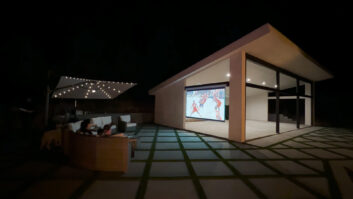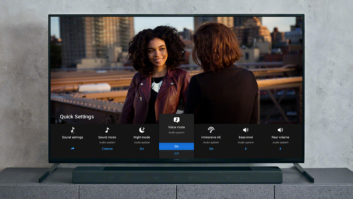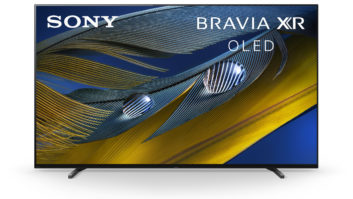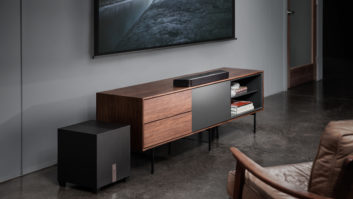Its not the fault of the nice folks behind it.
You certainly cant blame them for promoting HDMI as the logical means of connection for high-definition digital audio/video content. Regardless, HDMI is being blamed for problems that sometimes are the fault of HDMI, but sometimes not.
HDMI (High Definition Multimedia Interface) is something that certain people will insist on, while others will say isnt ready for prime time. No matter which of these options describes where you (or your prospects and clients) fit in, HDMI may often be best described by quoting an old clich: You cant live with it, you cant live without it.
By way of review, HDMI is a digital interface technology capable of carrying digital video signals along with audio and control information. The video and audio are one way, always moving upstream from a source to the ultimate destination in a sink. The command signals, formalized under the banner of CEC (Consumer Electronics Control), are two-way, as you would expect given their task. Built on the digital video technology of the DVI (Digital Video Interface) standard first intended as a replacement for analog video connections between computers and video displays, HDMI may be found in a variety of device types, configurations, and version levels.
An HDMI source, as the moniker implies, is where a signal originates. It may be a standard-definition DVD player with an upscaled output. It may be a cable box or satellite receiver. It may be an ATSC digital tuner in a standalone configuration or built in to an integrated display. It may be a video game, or it may be a camcorder. The signal on a sources HDMI output must be digital, though as with all digital television, it may or may not be high definition. The signal will be encoded with the HDCP content protection system carrying with that the rules governing HDCP-encoded material, sometimes causing issues blamed on the HDMI connection that are not HDMIs fault.
At the other end is a sink, the nomenclature for the end of the road, or the device where the signals in the HDMI pipe get decoded, decrypted as required, and displayed.
Where part of the fun comes in is for the third category of device, an HDMI repeater, which receives the HDMI signal (Rx in tech talk), has the ability to process it, equalize it, re-encode or encrypt it as needed or required, and then pass it down the line by transmitting it out to the next device in the chain (Tx). On the simplest level, a repeater is just that: a device takes the signal in and re-transmits it so that the distance between the source and the sink may be longer than the nominal limit for single cable, source-to-sink connections. The fun begins when the repeater is part of a device such as an A/V receiver or surround sound processor that actually takes the signal after the Rx stage, looks at it, and deals with the audio and video for tasks such as digital audio decoding or video processing, and then gets the HDMI to act together for Tx.
To all appearances that might be a good thing. After all, you are able to take advantage of the one-wire connectivity while letting the intermediary device (the AVR/repeater) deal with the audio, while the video goes down the line to the sink, and at a greater distance from the source, at that. Oh, that it was always so!
One of the greatest problems encountered with HDMI products to date falls into this category, as some of the sources, most notably some cable set-tops, do not recognize the presence of any device between itself and the sink. Insert another HDMI device in the middle, no matter how proper its design and software might be, and the system chokes with no signal visible on the sink. There are fixes for this that typically involve a firmware upgrade to the source, but if the fix isnt available, try and explain all of this to a client when youve just sold them on the benefits of HDMI.
Also worth throwing into the mix is HDMIs CEC feature set, which, when implemented, further simplifies system installations with a true one-cable hookup by providing a bi-directional control path for component commands. As has long been the case in some of the proprietary remote link systems, or with 1394-based HAVI systems, CEC is the latest attempt at having one remote control all components in the chain. Select DVD as your system input and all relevant devices turn on, switch sources and any configuration settings, and youre ready to go! is the idea here.
Other HDMI issues to date are also things that software changes along the way will solve, such as peculiarities in the turn-on sequence required when multiple HDMI devices are in a signal path. However, the one thing for which everyone has been waiting, HDMI Version 1.3, was formally released this past June. Now that the cat is out of the bag, how does that affect you at ground level?
Before going further, it is helpful to remember the progression of HDMI versions and to highlight why 1.3 is so important, or not. The original version 1.0 is the basic standard that details carrying digital video at a rate up to 165 MHz and PCM audio. It should be noted that even this first version of the format standard permits connected devices to support 1080p video, provided that they are designed to do so. Any limitation that prevents the carriage of 1080p is in the system and component design, and is not a by-product of HDMI. The 1.1 version, released in May 2004, added the capability to carry DVD-Audio over through HDMI connections. The major improvement in the 1.2 edition of the standard, released in August of 2005, and the major advancement there for the consumer electronics industry, was the addition of support for one-bit audio systems such as SACD. The other parts of the 1.2 specs pertain more to the connection of computers to monitors, than to CE devices. Quickly following in December, 2005, was version 1.2a, which added the technology needed to support CEC along with additional compliance test specifications for the format as well as the physical connectors.
Keep this progression in mind as the next step in the HDMI saga is to tell you what the latest and greatest version brings to the party. HDMI 1.3 does a number of things, but the key is that while some are important now, some are down the line improvements.
Item: Versions 1.3 now has the ability to support transmission of the new lossless digital audio formats, including Dolby TrueHD and DTS-HD Master Audio.
Benefit: This is the one everyone has been waiting for, as it makes good on the promise of finally making possible the holy grail of a one-cable link from source to AVR or processor and then on to the display sink.
Caution: Dont let the euphoria over the 1.3 standards capabilities confuse your clients to the point where they think it is around the corner. HDMI 1.3 is only part of the system, albeit an important one. Before you use an end-to-end 1.3 solution for these new formats well have to wait for receivers and processors that not only have HDMI 1.3, but also need to have DSP processor chips with the horsepower to deal with the lossless codecs, and the code to do that has to be made available from Dolby and DTS. No word yet on when that will happen. Oh, and add in the time for manufacturers to fit all of this into their product development cycles, test everything out, and go back to the licensors for compliance testing.
Item: System bandwidth more than doubles from the original 165 MHz/4.95 gigabits/sec to 340 MHZ/10.2 gigabits/sec.
Benefit: Allows for higher resolution down the line, but remember that this, alone, does not make 1080p possible.
Caution: Depending on the architecture of system components, some products with earlier revision versions are 1080p capable, and while most 1.3 products will, 1.3 alone is no guarantee.
Item: Deep color with color depth possible up to 48-bit, up from the 24-bit maximum in the current standards.
Benefit: Displays will be able to enable increased contrast and billions, instead of millions of colors, they can eliminate banding and smooth color tone transitions and four times more shades of gray are able to be transmitted.
Caution: At first, the deep color benefit will only come from products such as PlayStation3, as that level of color depth is way down the line for other sources. Similarly, you need 1.3 in all parts of the system for the deep color to reach through from the source to the sink and of course, the display has to be able to do something with the depth of color in the signal.
Item: Mini connector is called out in the specs.
Benefit: When the connector is available, HDMI will begin to appear on more devices than todays DVD players, set-tops, and the forthcoming PS3 consoles.
Caution: None to speak of, but it will be some time before this part of the spec is a reality.
Item: Lip sync compensation.
Benefit: No more fiddling with controls on the AVR or processor to bring audio and video in sync when aggressive video procession, too many encode/decode steps, or transmission path issues throw things out of whack.
Caution: Again, something that cant arrive too soon, but dont promise this automatic system for the short term.
With all of the HDMI cards on the table, it becomes clear that HDMI 1.3 was worth the wait. However, some of those benefits will only deliver their full value at some point in the future when the system is Version 1.3 all the way through. But with all the attention focused on the latest version of HDMI, particularly in industry online forums and chat areas, the question is when will this all fall into place in terms of deliverable products?
As with all things HDMI, the answer is multi-tiered. First, understand (or be ready to explain to clients expecting 1.3 products in the systems that you are currently specifying) that the mere announcement of the standard does not mean that products fall off the back of the truck the next day. The standard not only has to be released, it may have to go through additional approvals and/or investigation and integration by the likes of the DVD Forum. Manufacturers have to figure out how to integrate the new protocol into product architectures, and sample chips have to be run and tested. Once the samples have passed muster, only then can full production commence, followed by delivery to factories, more testing and compliance, and finally, product shipment.
According to Silicon Image, the driving force behind HDMI, the first HDMI 1.3-equipped product will be PlayStation3, to possibly be followed by some additional, but un-named products in 2006. More products will be shown at CES, but there, too, caution is advised. Shown does not mean shipping, and the real availability date for HDMI 1.3 products will stretch throughout the first half of 2007. The SI statements leave the impression that source products will lead the market in HDMI 1.3 implementation, followed by displays, and then the stuff in the middle will gradually find its way to the market throughout the year.
There are more cautionary notes. HDMI 1.3 for the sake of 1.3 does not mean that all features will be operational. SI noted in its most recent teleconference for financial analysts that it might not be until late 2007 or early 2008 before we see more products equipped to generate or display deep color. The same thing goes for those waiting for camcorders or still cameras with the mini connector. Dont expect to see them until mid-2007, at the earliest. Perhaps recognizing the attention that they have focused on their own technologies, SI commented that the usual product introduction cycles will not apply here, and that we should look at different times of the year for new [consumer electronics market/1.3-equipped] products.
Another note came at Denons product preview in late July. Falling into line with the statements from Silicon Image, they put the introduction of their first 1.3-equipped products off until sometime in the first half of 2007. Is the sky falling? Does all of this mean that you shouldnt sell or install any HDMI-equipped products for six to 12 months? No, of course not!
The bottom line is to proceed as needed for the present while planning for the future. Proceed, however, with caution. There are displays in the market that accept 1080p input sources using the current HDMI versions. There are, or shortly will be, source devices with 1080p outputs over HDMI. There are not yet any surround processors or A/V receivers that have the capability to handle the lossless audio formats, but that doesnt stop you from letting consumers access those formats via the analog outputs of blue laser-based systems.
In fact, the last thing you want to do is hold back and wait. If the explanations here have done nothing else, they should communicate the message that yes, HDMI is evolving and will soon offer more capabilities, but at the same time it is backwards compatible. Dont be caught up in the confusion, but rather take advantage of the opportunities to not only be honest with clients, but be creative in your system proposals that give them the best of what is available today while making clear which components are hardware or software upgradeable and which might need to be replaced on a sooner than normal schedule.
Carefully explain the benefits that the new extensions to HDMI bring, and show where you can deliver now what they are promising for down the line. For example, if a client is hung up on waiting for the capabilities of CEC, respond by demonstrating how youve been doing that sort of thing for years with system automation and touch panels. If the client is insistent on deep color, explain that it will be some time before that capability is widely available, and that even where the source delivers it today, it may be well into tomorrow before there are displays that can show it.
Yes, there will be instances where the confusion of handshake problems with HDMI products has given the technology a bad rap in some circles, but that is being solved at the same time as knowledgeable installers are dealing with work-arounds. Some of the problems being encountered in the field today are the cause of technologies that are complementary to HDMI in the wide, wide world of digital television transmission and display, such as HDCP copy protection and the EDID system that lets displays and sources talk to one another. Youll have to live with some of that as you work around other parts of the task of simplifying the increasingly complex range of video configurations.
Michael Heiss ([email protected]) is a technology and marketing consultant based in Los Angeles.







